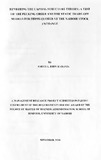| dc.contributor.author | Mbugua, John K | |
| dc.date.accessioned | 2012-11-13T12:37:36Z | |
| dc.date.available | 2012-11-13T12:37:36Z | |
| dc.date.issued | 2010 | |
| dc.identifier.uri | http://erepository.uonbi.ac.ke:8080/handle/123456789/5784 | |
| dc.description.abstract | The objective of this study was to simultaneously examine the pecking order and trade-off theories of capital structure and determine which of the theories guide capital structure choice for firms quoted at Nairobi stock exchange. The research design was causal design. The population of the study was the firms quoted in the Nairobi Stock Exchange between 2005-2009. At the time of the study there were 47.
The data gathered was secondary data from income statements, statements of financial position and cash flow statements from annual reports filled with capital market authority (CMA).
Data analysis was through regression analysis. A simple and an extended pecking order models were employed to test the pecking order hypothesis, while a single model was used to test the trade off theory.
The study found out that the extended POM was more significant at 5% level in explaining change in debt while the simple model was not significant. Trade-off model was found to be insignificant at 5% level in explaining change in debt. The findings are interesting as they contradict the views held in financial literature that firms care about tax shield benefit derived from employing both debt and non- debt tax shield.
It was surprising to find that a negative relationship exists between asset structure and change in debt and that Kenyan firms are not driven by nature of their assets in determining whether to borrow. The study recommends that other factors be included in analyzing the pecking order theory of firms other than internal funds deficiency for firms listed at NSE so as to improve the predicting power of the model. The study also recommends inclusion of dividend payment, changes in working capital and debt repayment as separate factors in explaining variations in debt in addition to being part of internal funds deficiency. | en_US |
| dc.language.iso | en_US | en_US |
| dc.publisher | University of Nairobi, Kenya | en_US |
| dc.title | Revisiting the capital structure theory: a test of the Pecking order and the static trade-off models for firms quoted at the Nairobi Stock Exchange | en_US |
| dc.title.alternative | Thesis (MBA) | en_US |
| dc.type | Thesis | en_US |

